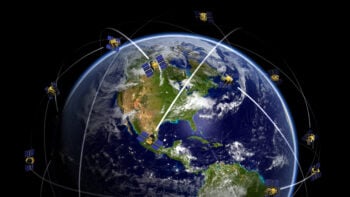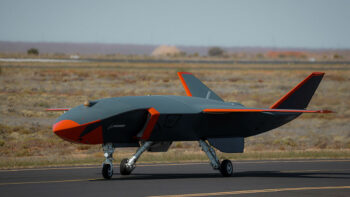
Office of Space Commerce Director Richard DalBello (center) and Travis Langster, DoD principal director of space policy (right) at the 2023 Space Symposium. (Space Foundation photo)
NEW YORK — The Commerce Department is planning at least two meetings with industry officials for July to discuss next steps in crafting a space traffic “coordination” system — including one with satellite operators designed in part to encourage better sharing of spacecraft location data with both the government and among themselves, according to a senior department official.
“We want to push them a little bit on sharing, because we think there are some better practices than those that are currently being done,” Richard DalBello, director of the Office of Space Commerce, said today. “So, it is our goal to work directly with people who are the satellite operators to understand what stresses are they under, what’s working, what’s not working.”
As a result of the 2018 White House Space Policy Directive-3, Commerce has been working to relieve the Defense Department of the burden for monitoring the ever-more crowded heavens and providing warnings to non-military space operators about potential on-orbit collisions. As first reported by Breaking Defense, the Office of Space Commerce in January issued a draft plan for a space traffic “basic” service, called Traffic Coordination System for Space, or TraCSS for short.
Speaking to the Secure World Foundation’s “Summit for Space Sustainability” here, DalBello explained that a key the question for industry is where are current sources of space monitoring data — which besides US Space Command now include commercial providers, as well as foreign governments — “falling short” of operator needs?
“What doesn’t exist that they want to see?” he said.
The Office of Space Commerce will hold separate “industry engagement session” with US companies that are offering space situational awareness (SSA) data for sale, DalBello said.
The relationship between the office’s nascent TraCSS and commercial SSA providers is a complex issue — involving not just the question of how hard that system should lean on industry-provided data as opposed to data from DoD, but also how the Commerce Department can avoid undercutting the growing market sector by providing free SSA data and services to satellite operators.
In particular, DalBello said, the issue of who buys what from whom is increasingly on the table.
“As the world gets more complicated, and there are more and more SSA providers, the issue of who pays will be one which continually gets battered around,” he said. While “right now, governments are paying for it,” he explained that it may be the case in the future that operators will need to pay something as well to be able to maintain the viability of services.
How to make use of commercially provided data also has proven a puzzle for the Space Force and SPACECOM. DoD for several years has been struggling to figure out how to ingest commercial data, despite officials oft-expressed desire to use commercial sources to fill gaps in the military’s own SSA capabilities.
The mismatch between rhetoric and action was highlighted by the Government Accountability Office in an April report [PDF].
“Space Force has some efforts underway to use commercial SSA data. However, it has not comprehensively evaluated the range of data available to help meet SSA mission needs. DOD strategy emphasizes using commercial options when possible,” the GAO report found. “However, the Space Force’s evaluation and acquisition of licenses to access, use, and potentially share commercial SSA data have been limited to a few studies and training events. Establishing a process to regularly identify and evaluate commercial SSA data would better position the Space Force to meet its growing need to identify and characterize space objects.”
‘No silver bullet:’ Military will need multiple systems to back up GPS
Each technique available now or in the foreseeable future for what is known as alt-PNT comes with a need to make size, weight, power and cost trade-offs based on what type of platform is being used, according to experts.



























